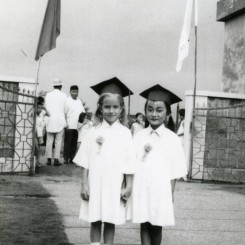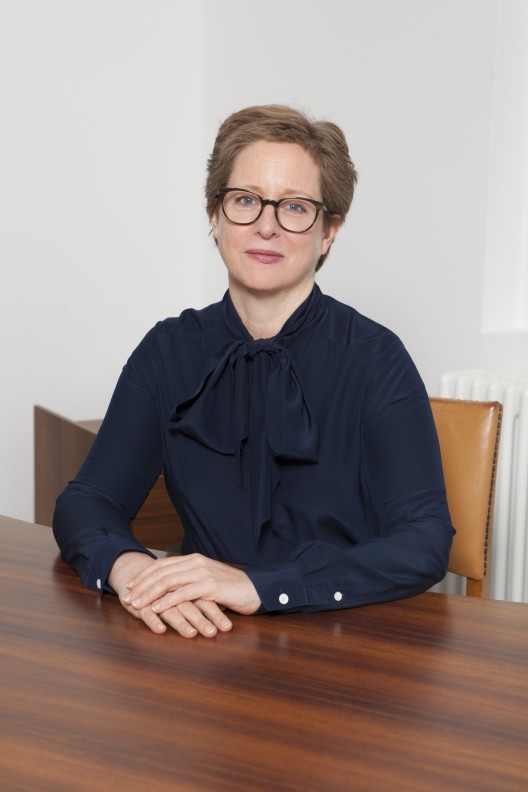by Chris Moore
Esther Schipper is one of the most influential gallerists in Europe. Her Berlin gallery has shown many of the artists who have come to dominate the intellectual scene, including one of the stars of this year’s dOCUMENTA, Pierre Huyghe, but also Dominique Gonzalez-Foerster, Angela Bulloch and Philippe Parreno. Randian met Schipper at her gallery to discuss how she became a gallerist and her thoughts on the role of art galleries now.
Chris Moore: Esther, could you begin by telling us how you became involved in art? What was it that drew you to become an art dealer?
Esther Schipper: My mother is an art historian, so I grew up with going to see a lot of exhibitions. My mother is Dutch, which is an important detail in this little story because she was always very fond of the activities of the Stedelijk Museum in Amsterdam, [which was] back in the seventies probably one of the most avant-garde and interesting museums in Europe. I grew up in Paris, so when we visited our Dutch relatives, we very frequently went to visit the Stedelijk Museum, and that’s something which I grew up with — Gilbert & George’s “living sculpture” or Ed Kienholz’s “Bar”.
CM: Did you consider becoming a curator or entering the museum system?
ES: Oh, that was all left very open at the time. It was just really the fact that I really kind of realized that this was the place I really wanted to be. Not so much in terms of what that would mean professionally but in terms of: these are the people I want to be surrounded by; these are the people I like, that I think are interesting; this is fascinating with all these things happening. And then, by another coincidence, I met Monika Sprüth, who had just opened her gallery and who was literally looking for somebody to do what is called “gallery sitting.” I mean that was at the time prior to Internet, fax machines, computers, whatever, and one had one telephone in the gallery and somebody needed someone to answer it when it was ringing, eventually open the door if somebody wanted to come and see the exhibition, and know where the pricelist was. And then in ’87, I went to Grenoble in France to do the post-graduate curating course at the L’École du Magasin .
CM: At the time, that course was quite unique, wasn’t it?
ES: Yes! The Whitney had something similar but after having worked for a couple of years in a commercial gallery I was very, very tempted by more institutional work. I did a three-month internship at the Whitechapel [Gallery]. I worked as a freelance curator. I opened a little office in Cologne where I did a few little commercial projects –– I published some multiples with Rosmarie Trockel, for instance, but also I did some projects with Rudolf Stingel and Thomas Locher. These were the things that helped me to make some money, and pay for the travelling, and the writing was also not something that I could make an existence upon. So I returned to Cologne and this little office very quickly became a gallery. And that was 1989.
CM: In 2008 you asked Phil Tinari to curate a show, CLYWX, with Chu Yun, Liu Wei, and Xu Zhen. What was the background to that show?
ES: I’ve been ten years on the board of ArtBasel and in 2007 we went to China to do field research on the gallerists over there. Now I was born in Taiwan in the early sixties. My father is a sinologist, a specialist in Daoism. I lived there until age seven and as a little child, in my first year of school there, I was fluent in Chinese. But I had never been to China [PRC] before. In 2007 my father was living in Fuzhou, so I first went to visit him and when I arrived in China, I just thought that it was so familiar to me — everything. I mean, after a week I started to understand parts of the language, the way things taste, the way people are. It’s kind of a “Marguerite Duras” kind of thing! It’s certainly not like coming home but it is, oh yes, definitely a part of you.
CM: Well I can empathize with that.
ES: Then we saw a lot, a lot, a lot — galleries, artists, shows, independent places, what have you — on that trip. I was kind of skeptical about what I would say are the kind of “Chinese Export Artists” that had gained the market in the 2000s. So I was really surprised to meet so many extremely interesting people and to see very intriguing works of art.
CM: Well, that said, you have a particular aesthetic in this gallery. Is there anything in particular you feel unites the artists you exhibit?
ES: I think that we are, as one says in German, a “Program Galerie.” Although I’m not really a big fan of this term “relational aesthetics,” I think that this is certainly a base of the gallery. The year I was in Grenoble, I met a few artists with whom I am still working today, people like Philippe Parreno and Dominique Gonzalez-Foerster. Then during my time in London, I met Liam Gillick and Angela Bulloch. Together we worked on defining and showing, but also commodifying, a form of art that does not always have a proper defined “object.”
CM: It’s a strange situation, in some respects, where a lot of this art which is criticising art production and distribution — in some respects its commodification is antithetical to its own program — and yet it is this very commodification that has helped its own distribution, its own success.
ES: I know what you mean, it’s just that…well, I think that the most interesting part for me in this whole chain — this whole food chain! [laughing] — is probably how do you wrap up an idea so that it can travel without the author? Sometimes it has a lot to do with clarifying the process. Pierre Huyghe made this wonderful piece, a big iceboat, which during the whole show was melting. But it’s not really complicated once you have an elaborate drawing and you work with ice sculptors, and whose work is to realize this kind of work. So we set up an outline how a work like this can be really refabricated pretty easily – much as it might be difficult to live with this piece!
The question how do you sell something like this can be put on a different level. You can try to conserve this one-time big iceboat, but somehow this doesn’t really contain the idea anymore, because you would set a complicated system to conserve something which is only a work when it slowly disappears.. So we were trying to define an economy for this kind of work. Maybe it’s rather clear if we take video art as an example. When Gerry Schum opened his “fernsehgalerie” in 1967, he aimed to find an economy for video art in mass distribution, thus television. But mass distribution and communication failed to be the right place for art. How do you set up an economy for media-based work, produced with a capacity for infinite multiplication in a market in which uniqueness prevails? Questions of edition sizes become content as well as an economy, and a unique film can also be a beautiful concept.
CM: Which is also perverse in some respects!
ES: Yes!
(The full version of this interview will be published at a later date.)


